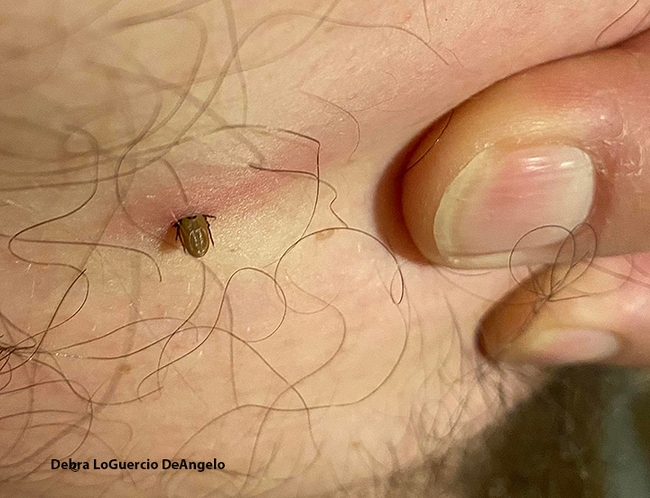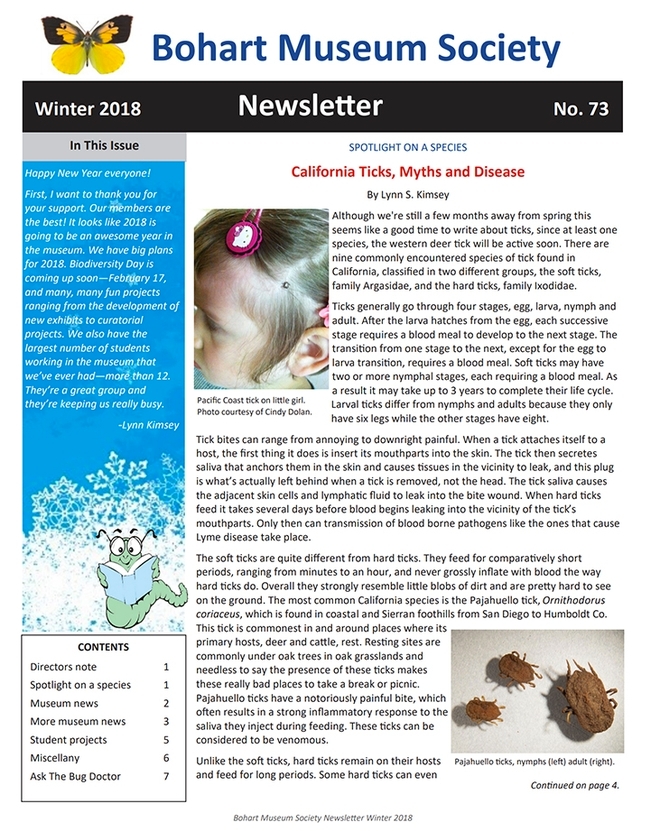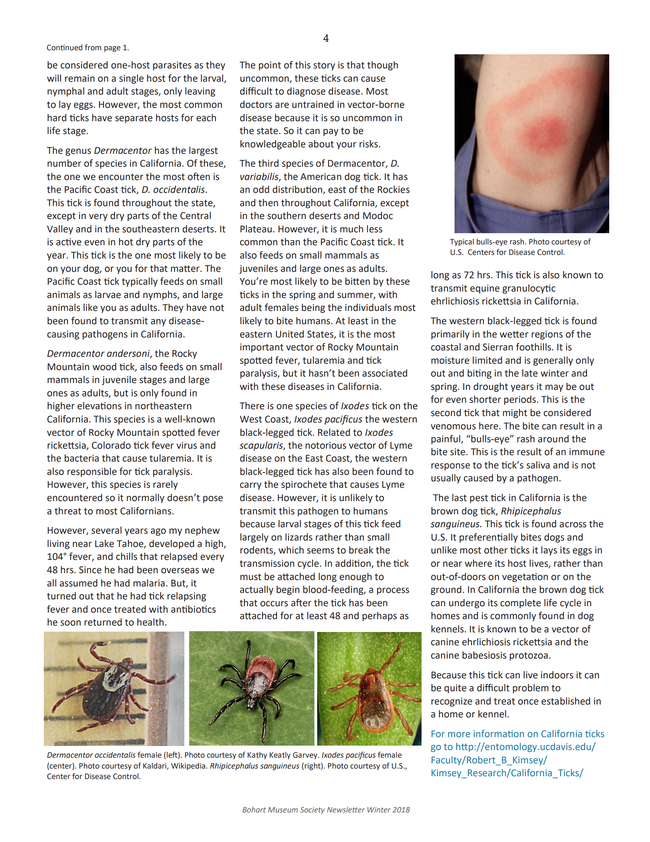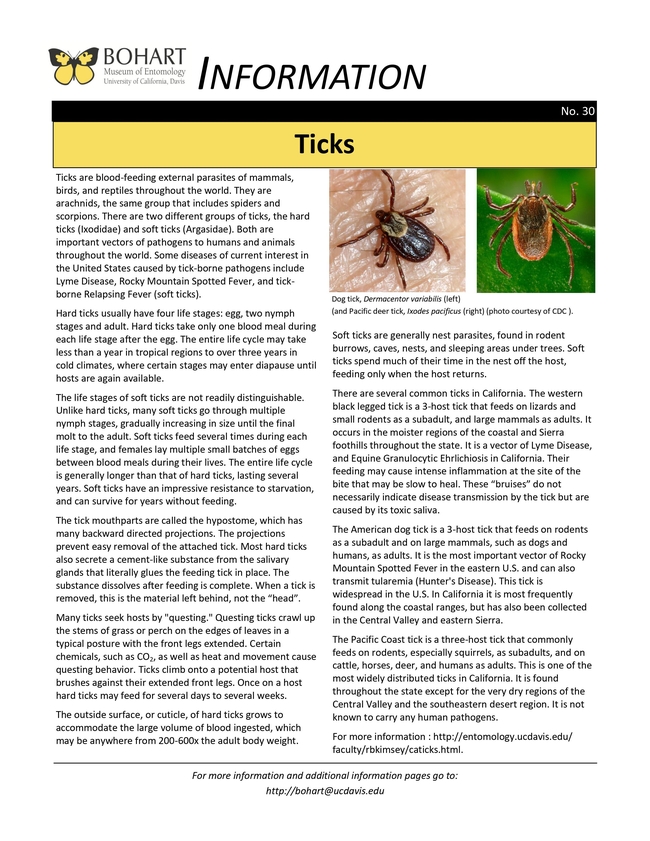- Author: Kathy Keatley Garvey

So Joe Nazarius of Winters embarked on a Dec. 30th hike in the Knoxville Road area, west of Lake Berryessa, when the unexpected happened.
"What is this bug buried in Joe's skin?"
That's what his wife, Debra LoGuercio DeAngelo, messaged me. She attached a photo.
Before I could read and respond, a trip to a nearby hospital's urgent care center confirmed its identity: a tick.
Lynn Kimsey, director of the Bohart Museum of Entomology at the University of California, Davis, and a UC Davis distinguished professor of entomology, further identified it as a "black-legged tick nymph (Ixodes pacificus). He should pull it out immediately as their saliva is pretty potent."
Yes and yes.
"It's definitely tick season," Professor Kimsey added. "Black-legged ticks are really winter-early spring ticks, followed by the common dog tick, which is the late spring-summer tick.”
Kimsey, who fields scores of questions about ticks, wrote a fact sheet on ticks (see below), posted on the Bohart Museum website:
"The tick mouthparts are called the hypostome, which has many backward directed projections. The projections prevent easy removal of the attached tick. Most hard ticks also secrete a cement-like substance from the salivary glands that literally glues the feeding tick in place. The substance dissolves after feeding is complete. When a tick is removed, this is the material left behind, not the 'head.'
"Many ticks seek hosts by 'questing.' Questing ticks crawl up the stems of grass or perch on the edges of leaves in a typical posture with the front legs extended. Certain chemicals, such as CO2, as well as heat and movement cause questing behavior. Ticks climb onto a potential host that brushes against their extended front legs. Once on a host, hard ticks may feed for several days to several weeks."
Kimsey also covered ticks in her lead article, "California Ticks, Myths and Disease," of the winter 2018 Bohart Museum Society newsletter (see entire article at the end of this blog):
"Although we're still a few months away from spring this seems like a good time to write about ticks, since at least one species, the western deer tick will be active soon. There are nine commonly encountered species of tick found in California, classified in two different groups, the soft ticks, family Argasidae, and the hard ticks, family Ixodidae.
"Ticks generally go through four stages, egg, larva, nymph and adult. After the larva hatches from the egg, each successive stage requires a blood meal to develop to the next stage. The transition from one stage to the next, except for the egg to larva transition, requires a blood meal. Soft ticks may have two or more nymphal stages, each requiring a blood meal. As a result it may take up to 3 years to complete their life cycle. Larval ticks differ from nymphs and adults because they only have six legs while the other stages have eight.
"Tick bites can range from annoying to downright painful. When a tick attaches itself to a host, the first thing it does is insert its mouthparts into the skin. The tick then secretes saliva that anchors them in the skin and causes tissues in the vicinity to leak, and this plug is what's actually left behind when a tick is removed, not the head. The tick saliva causes the adjacent skin cells and lymphatic fluid to leak into the bite wound. When hard ticks feed it takes several days before blood begins leaking into the vicinity of the tick's mouthparts. Only then can transmission of blood borne pathogens like the ones that cause Lyme disease take place."
But back to "The Tick" that interrupted an end-of-the-year hike.
Most people might not pull out their cell phone to grab an image of a tick, but Debra LoGuercio DeAngelo is a journalist. She's a former editor of the Winters Express newspaper and author of two newly published books (The Elements of Horse Spirit: the Magical Bond Between Humans and Horses and Pagan Curious: A Beginner's Guide to Nature, Magic & Spirituality and a third one is pending publication in August, Sacred Massage--The Magic & Ritual of Soothing Touch)
With a click, Debra captured an extremely sharp image of "The Tick" that ticked them off.
No, her pending book on "soothing touch" has nothing to do with arachnids questing near Lake Berryessa and feasting on an unsuspecting hiker...but this talented writer may also have a future in tick photography...






